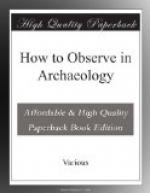In these periods, weapons, implements, and ornaments are of copper (with bronze in the ‘late’ period); gold occurs rarely; terra-cotta figures are few and rude; engraved seals are cylindrical like those of Babylonia.
Early Iron Age: wheel-made pottery, either white or bright red, with painted geometrical ornament in black (supplemented on the white ware with purple-red); there is also a black fabric imitating metallic forms.
The early period (1200-1000 B.C.) marks the transition from bronze to iron implements, with survival of Mycenaean decoration on the pottery, and replacement of cylindrical by conical seals.
The middle period (1000-750 B.C.) has purely geometrical decoration: terra-cotta figures are modelled rudely by hand, and painted like the pottery.
The late period (750-500 B.C.) shows foreign influences from Greece and from Phoenicia or Egypt, competing with and enriching the native geometrical style. Scarab seals, blue-glaze beads, and other personal ornaments, and silver objects, appear. Terra-cotta figures stamped in a mould occur side by side with modelled.
Hellenic Age, with increasing influence of Greek arts and industries.
Early or Hellenic period (500-300 B.C.): the native pottery degenerates, and Greek vases and terra-cottas are imported and imitated; jewellery of gold and silver is fairly common and of good quality; with engraved seals set in signet rings: the bronze mirrors are circular, with a handle-spike.
Middle or Hellenistic period (300-50 B.C.): the native pottery is almost wholly replaced by imitations of forms from other parts of the Greek world, especially from Syria and Asia Minor: large handled wine-jars (amphorae) are common: terra-cottas and jewellery also follow Greek styles: coloured stones are set in rings and ear-rings.
Late or Graeco-Roman period (50 B.C.-A.D. 400): pottery is partly replaced by vessels of blown glass: clay lamps, red-glazed jugs, so called ‘tear-bottles’ of spindle-shapes, ear-rings of beads strung on wire, bronze rings and bracelets, circular mirrors without handles, and bronze coins are characteristics.
Byzantine Age (after A.D. 400): Christian burial in surface graves supersedes the use of rock-hewn tombs: funerary equipment goes out of use, except a few personal ornaments, which are of mean appearance, and may bear Christian symbols. Domestic pottery is coarse, ungraceful, and frequently ribbed on the outside. Clay lamps have long nozzles, and Christian symbols. Glass becomes clumsy and less common; and glazed bowls and cups come into use. Occasional rich finds of silver plate (salvers, cups, spoons, &c.) and personal ornaments, have been made among Byzantine ruins.
On mediaeval and later sites, various glazed fabrics of pottery are found, and occasionally examples of the glazed and painted jugs, plates, and tiles known to collectors as ‘Rhodian’ or ‘Damascus’ ware.




